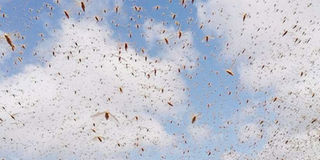Spraying locusts will not save crops, top entomologist says

Desert locusts invade Taiboto, Isiolo County. At this time there is very little that can be done to help the affected farmers. PHOTO | FILE | NATION MEDIA GROUP
What you need to know:
- But in the long term, concerned personnel should carefully monitor hopper bands on the ground in areas were locusts are known to lay their eggs.
- Locusts are a first-quality source of proteins for both people and animals. They are followed by birds and mammals.
As Kenya battles swarms of desert locusts ravaging parts of the country, Peter Neuenschwander of the International Institute for Tropical Agriculture (IITA) warns that the ongoing spraying may not save any crop or vegetation.
Prof Neuenschwander, who in the 1990s oversaw a programme that developed alternatives for chemical control of locusts and grasshoppers, spoke to Verenardo Meeme.
What should Kenya do in the short and long term to win this war on locusts?
In my opinion, at this time there is very little that can be done to help the affected farmers.
But in the long term, concerned personnel should carefully monitor hopper bands on the ground in areas were locusts are known to lay their eggs.
As soon as conditions for their development are conducive, biopesticides such as Green Muscle should be applied. This will prevent the eggs from maturing into locusts.
Is eating both by humans and animals an option of locust control?
Yes, locusts are a first-quality source of proteins for both people and animals. They are followed by birds and mammals.
As long as they have not been sprayed with insecticides (which at this stage are almost ineffective) they can be consumed. Greater efforts at collecting them for food might be envisaged.
How is this related to climate change?
Locust swarms are so infrequent that it is probably very difficult to link them with climate change. However, increased effects of local El-Niño might influence their ecology.
In hindsight, what could have been done to avert this invasion?
We always have 20-20 vision. Eastern and Southern Africa have excellent organisations dedicated to the forecasting of locust outbreaks.
If such organisations are only used once in a human’s lifetime they tend to become rusty or partially dismantled. Revitalising them should now be a priority.
What biocontrol solutions are available to these countries?
Green Muscle is the best biocontrol pesticide that can be used.
A biocontrol pesticide is one which only kills the target insect without affecting non-target insects, the environment and human health.
After the last big outbreak in 1989, the donor community insisted on avoiding the usual insecticide spray campaigns and asked CABI and IITA, in collaboration with the affected countries to develop a bio pesticide.
An Africa-wide search for strains of what was later to become Metarhizium anisopliae was undertaken and an effective strain from Niger was selected and an effective biocontrol pesticide, Green Muscle, was developed.
The patent was housed within Centre for Agriculture and Biosciences International (CABI), with IITA and Niger as minor contributors.
Since locust swarms are known to be infrequent, care was taken from the beginning to make sure the product also found a perennial niche, namely against the yearly outbreaks of grasshoppers in the Sahel zone.
Production started at IITA, was then picked up by a South African company. Despite the fact that Food and Agriculture Organisation officially recommend Green Muscle for control of locust hopper bands, production mostly ceased.
The Australians picked up the technology for use against their locusts and commercialised a product they called Green Shield.
Green Muscle was also used in Central Asia, but whether it is still available I do not know.
What should the neighbouring counters of Uganda and Tanzania do in order to stop the locusts from reaching their countries. Should they even be worried?
Neighbouring countries should also focus on the long-term measures as suggested above. Locust swarms are highly fidgety and the direction they move is hard to foresee.
The last big outbreak in northern Africa ended only when the swarms were blown off into the Atlantic, sometimes as far as Brazil.
Any other advice?
A recent article in American Entomologist by Allant T. Showler summarises the findings concerning locust control.
His most important message is that preventive control is mostly ineffective, so is spraying locust swarms.
The key to success is the detection of moving hopper bands and their treatment. If Green Muscle is available, it would be the perfect solution.




